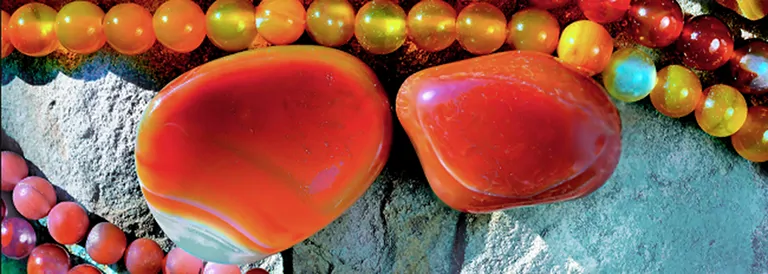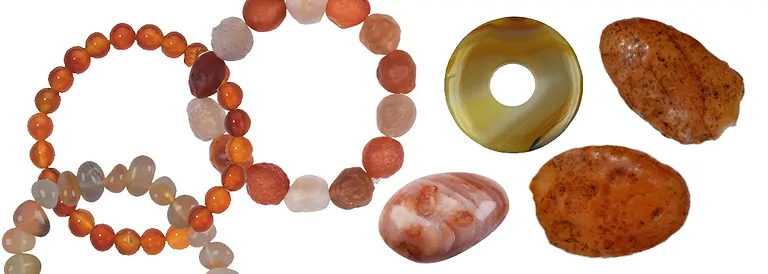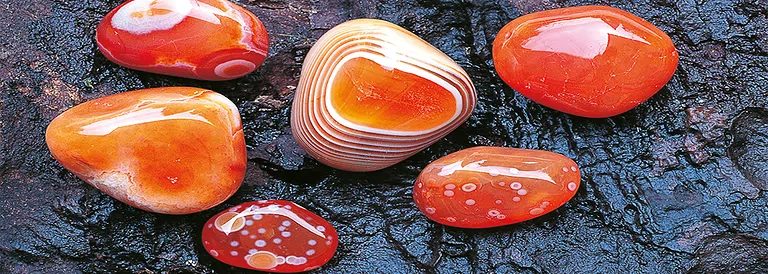
Carnelian - Meaning and Effect
Carnelian gives steadfastness and courage to (continue) to go the right way to success. Emerging difficulties can be quickly recognized and pragmatically solved, started projects are brought to a good conclusion. Also the togetherness is strengthened by the Carneliab, since helpfulness and idealism are supported: not only personal success is the focus, but also the community.
Carnelian - Names & Synonyms
The origin of the name carnelian is not certain - for this there are two theories: Either the name is derived from the Latin term "cornum" for Cornelian cherry or from "carneus", Latin for "flesh-colored". Even in ancient times, the orange and brown varieties of carnelian were called Sarder. In trade, carnelian is occasionally also called serdolik, frequently encountered are also the designations coraline / coraline, blood agate or flesh agate.
Mineralogical profile Carnelian
Chemical formula: SiO2(Fe,O,OH),
Mineral Class: quartz group, variety of chalcedony family
Color: yellow, orange, orange-red, reddish brown, brown; coloring metal is iron (see formation)
Shine: waxy
Crystal system: trigonal
Moh hardness: 6.7 to 7
Spaltability: none.
Break: conchoidal
Occurrence: Australia, Botswana, Germany, Russia, India, Japan, Madagascar, Namibia, Uruguay. Carnelian items available on the market are mainly from Botswana, India and Madagascar.
Origin: primary-hydrothermal in volcanic rocks. Highly hydrous silica solution penetrates the rock, absorbing iron oxides and crystallizing as it cools and slowly dries out. When it is formed, the silica must must be strongly water-containing, otherwise the color-giving iron oxide is not finely distributed to give the stone its color, but is precipitated out.

Meaning and application of Carnelian
Carnelian is a gemstone that conveys stableness, sense of community and idealism. He promotes good humor, courage to face life and helps to enjoy the beautiful while keeping both feet on the ground. He also supports the concentration, the sense of reality, a pragmatic-realistic approach and strengthens self-confidence. Carnelian has been a popular gemstone for thousands of years, giving energy and drive. Carnelian is worn as necklace, pendant, ring stone or Earrings worn, as a drum or Smooth Stone placed on the abdomen, as it is particularly well suited to activate the navel chakra.
Also to strengthen courage and assertiveness Carnelian can provide valuable support due to its effect: It motivates to form your own opinion, to find your own point of view and to represent it confidently. It helps, not to be beaten down, but to face the fellow men also sometimes courageously and to offer the forehead.
The stone is carried along with pleasure as a pocket stone in the trouser pocket and serves as a hand flatterer which unfolds its effect by regular contact with the palms. Also for the energization of water and as a gemstone essence Carneol can be used for application. Carneol helps especially well by prolonged wearing with direct skin contact.
Since carnelian can be processed and carved very well, small ornamental figures and statuettes have been carved from the red-orange stone since time immemorial; also, the mineral - especially in Asia - is worn with pleasure as an amulet. Depending on the historical source, either a carnelian necklace made around 3500 BC or the famous signet ring of Tello (ca. 2500 BC) is the oldest piece of carnelian jewelry in the world.
In "Steinwesen im Medizinrad" carnelian stands for the pleasant-warming life force; the assigned affirmation is "Positive life force fills me. All my cells are refueled, and I am well nourished."
Carnelian as a chakra stone
Red and orange, the main colors of Carnelian, are the colors of life, vitality and energy. Carnelian is associated with the second chakra, whose themes are relationships, encounters, affection and also creativity. The second Chakra is a hand width below the navel and the energy of the Carnelian can develop there as a stone or chakra stone particularly well their effect. The second chakra is also called the sexual chakra and Carnelian can lead to a more relaxed and fear-free and relaxed attitude towards one's body.

Heated Carnelian
As a rule, carnelian naturally grows to only a few centimeters in size and usually has a rather inconspicuous yellow-brownish coloring. However, to meet the great demand for intensely orange-red Carnelian for drilled stone pieces, engravings and polished articles, Agates and inconspicuous Carneol are burned. In this process, the stone is heated so that iron hydroxide is converted to iron oxide by the action of heat. Also we have in our wholesale assortment mainly articles made of burnt carnelian; this is identified by the addition "gebr.". So each customer can decide for himself whether he wants to buy the burned, usually more colorful carnelian or the rather inconspicuous natural carnelian.
Historical facts about Carnelian
The Sumerians used carnelian for seals, rings and especially for cylindrical pendants. Thus, it is mentioned in the great Sumerian epic Gilgamesh more than 4500 years ago. Unfortunately, carnelian is mentioned in the parts of Gilgamesh, which were largely lost, so it is unknown what exactly was written about the stone.
From Johann Wolfgang von Goethe (1749 - 1832), who also dealt with stones and minerals in his extensive works, comes the verse (from the West-Eastern Divan): "Talisman made of carnelian, to the faithful it brings luck and good fortune." In Muslim culture, people like to carve suras in carnelian and it is very popular as a ring stone, especially for signet rings. Thus also Martin Luther (1483 - 1546) carried a golden signet ring with an engraved carnelian. Today, this well-known piece of carnelian jewelry is on display in the Grünes Gewölbe in Dresden.
Also in ancient Egypt there are signs that people were fascinated by Carnelian because of its strong orange color. Since its color reminds of blood, it was considered with the Egyptians as life stone and was and was often added to tombs, e.g. also to the tomb of Tutankhamen. Numerous excavations, e.g. of Phoenician and Etruscan settlements, in addition, in Troja, pieces of jewelry from Carneol brought to the light.